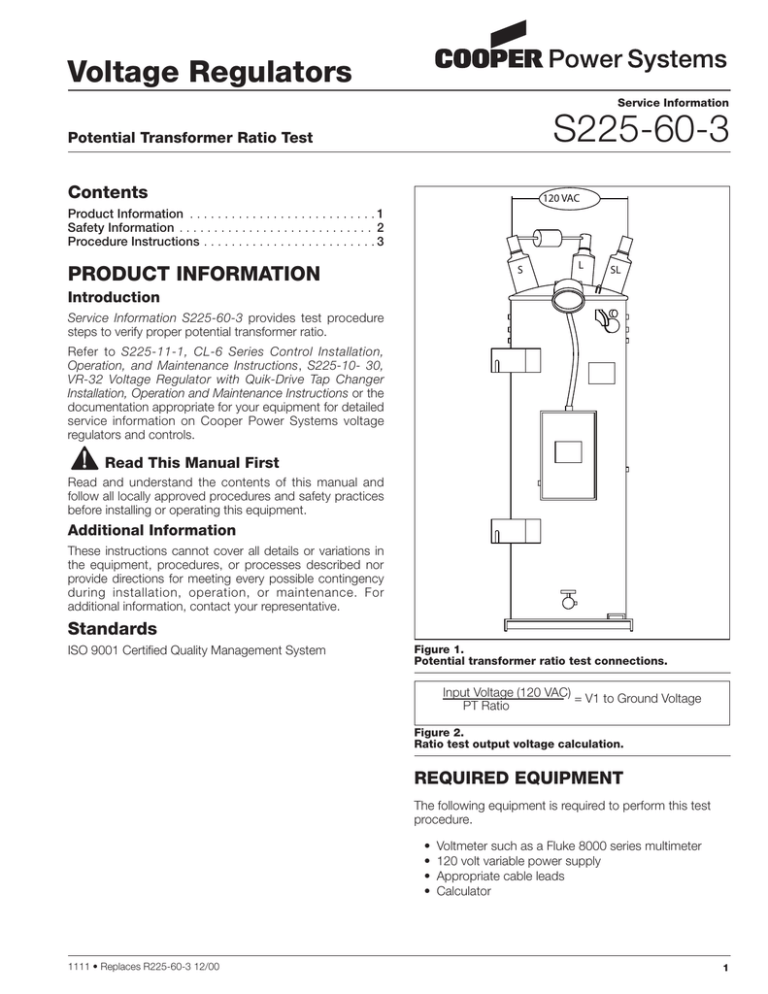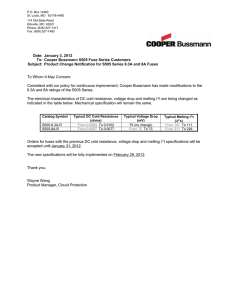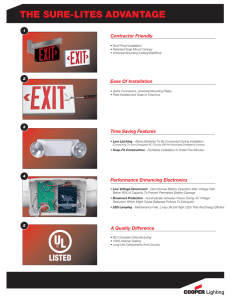
Voltage Regulators
Service Information
S225-60-3
Potential Transformer Ratio Test
Contents
120 VAC
Product Information . . . . . . . . . . . . . . . . . . . . . . . . . . . 1
Safety Information �������������������������������������������������������� 2
Procedure Instructions . . . . . . . . . . . . . . . . . . . . . . . . . 3
Product Information
S
L
SL
Introduction
Service Information S225-60-3 provides test procedure
steps to verify proper potential transformer ratio.
Refer to S225-11-1, CL-6 Series Control Installation,
Operation, and Maintenance Instructions, S225-10- 30,
VR-32 Voltage Regulator with Quik-Drive Tap Changer
Installation, Operation and Maintenance Instructions or the
documentation appropriate for your equipment for detailed
service information on Cooper Power Systems voltage
regulators and controls.
!
Read This Manual First
Read and understand the contents of this manual and
follow all locally approved procedures and safety practices
before installing or operating this equipment.
Additional Information
These instructions cannot cover all details or variations in
the equipment, procedures, or processes described nor
provide directions for meeting every possible contingency
during installation, operation, or maintenance. For
additional information, contact your representative.
Standards
ISO 9001 Certified Quality Management System
Figure 1.
Potential transformer ratio test connections.
Input Voltage (120 VAC) = V1 to Ground Voltage
PT Ratio
Figure 2.
Ratio test output voltage calculation.
Required Equipment
The following equipment is required to perform this test
procedure.
• Voltmeter such as a Fluke 8000 series multimeter
• 120 volt variable power supply
• Appropriate cable leads
• Calculator
1111 • Replaces R225-60-3 12/00
1
Potential Transformer Ratio Test
!
SAFETY
FOR LIFE
SAFETY FOR LIFE
!
SAFETY
FOR LIFE
Cooper Power Systems products meet or exceed all applicable industry standards relating to product safety. We actively
promote safe practices in the use and maintenance of our products through our service literature, instructional training
programs, and the continuous efforts of all Cooper Power Systems employees involved in product design, manufacture,
marketing and service.
We strongly urge that you always follow all locally approved safety procedures and safety instructions when working
around high-voltage lines and equipment and support our “Safety For Life” mission.
SAFETY Information
The instructions in this manual are not intended as a
sub­s titute for proper training or adequate experience
in the safe operation of the equipment described.
Only competent technicians, who are familiar with this
equipment should install, operate and service it.
A competent technician has these qualifications:
nIs thoroughly familiar with these instructions.
nIs trained in industry-accepted high- and low-voltage
safe operating practices and procedures.
nIs trained and authorized to energize, de-energize, clear,
and ground power distribution equipment.
nIs trained in the care and use of protective equipment
such as flash clothing, safety glasses, face shield, hard
hat, rubber gloves, clampstick, hotstick, etc.
Following is important safety information. For safe
installation and operation of this equipment, be sure to
read and understand all cautions and warnings.
Hazard Statement Definitions
This manual may contain four types of hazard
statements:
!
DANGER:
Indicates a hazardous situation which, if not
avoided, will result in death or serious injury.
!
WARNING:
Indicates a hazardous situation which, if not
avoided, could result In death or serious injury.
!
CAUTION:
Indicates a hazardous situation which, if not
avoided, could result in minor or moderate injury.
Caution: Indicates a hazardous situation which,
if not avoided, could result in equipment damage
only.
2
Safety Instructions
Following are general caution and warning statements that
apply to this equipment. Additional statements, related to
specific tasks and procedures, are located throughout the
manual.
!
DANGER:
Hazardous voltage. Contact with high voltage will
cause death or severe personal injury. Follow all
locally approved safety procedures when working
around high- and low-voltage lines and equipment.
!
WARNING:
Before installing, operating, maintaining, or testing
this equipment, carefully read and understand
the contents of this manual. Improper operation,
handling or maintenance can result in death, severe
personal injury, and equipment damage.
!
WARNING:
This equipment is not intended to protect human
life. Follow all locally approved procedures and
safety practices when installing or operating this
equipment. Failure to comply may result in death,
severe personal injury and equipment damage.
!
WARNING:
Power distribution and transmission equipment
must be properly selected for the intended
application. It must be installed and serviced
by competent personnel who have been trained
and understand proper safety procedures. These
instructions are written for such personnel and
are not a substitute for adequate training and
experience in safety procedures. Failure to properly
select, install or maintain power distribution and
transmission equipment can result in death, severe
personal injury, and equipment damage.
!
SAFETY
FOR LIFE
S225-60-3
procedure instructions
1. With the regulator in the neutral position, connect
120 VAC between the source "S" and the sourceload "SL" bushings as shown in Figure 1.
2. Open the backpanel knife switch marked V1.
Measure the voltage between the top of the V1 knife
switch and the top terminal strip ground TB1-G.
(TB3-G on short alternate back panel.)
3. Note the correct PT ratio as given on the nameplate
under the Internal PT Ratio column for the pinned
Load Voltage.
4. Verify the internal tap setting of the PT by inspecting
the top of the tap changer board located under the
regulator cover handhole. It will be E1, E2, E3, etc.
This should correspond to the Control Winding Tap
for the pinned voltage on the nameplate.
5. Using the formula in Figure 2, determine what the
correct output voltage should be and compare it to
the actual reading as seen on the voltmeter across
the control test terminals. Example: If the ratio is
shown as 60:1, then the V1 to ground voltage will be
(120 VAC/(60) = 2.0 volts
Questions about the described procedure may be directed
to your Cooper Power Systems Representative.
3
Potential Transformer Ratio Test
!
SAFETY
FOR LIFE
© 2011 Cooper Industries. All Rights Reserved.
Cooper Power Systems is a valuable trademark of Cooper Industries in the U.S. and
other countries. You are not permitted to use the Cooper Trademarks without the prior
written permission of Cooper Industries.
One | www.cooperpower.com | Online
S225603 Rev. 1 (Replaces R225603 Rev. 0)
2300 Badger Drive
Waukesha, WI 53188 USA






